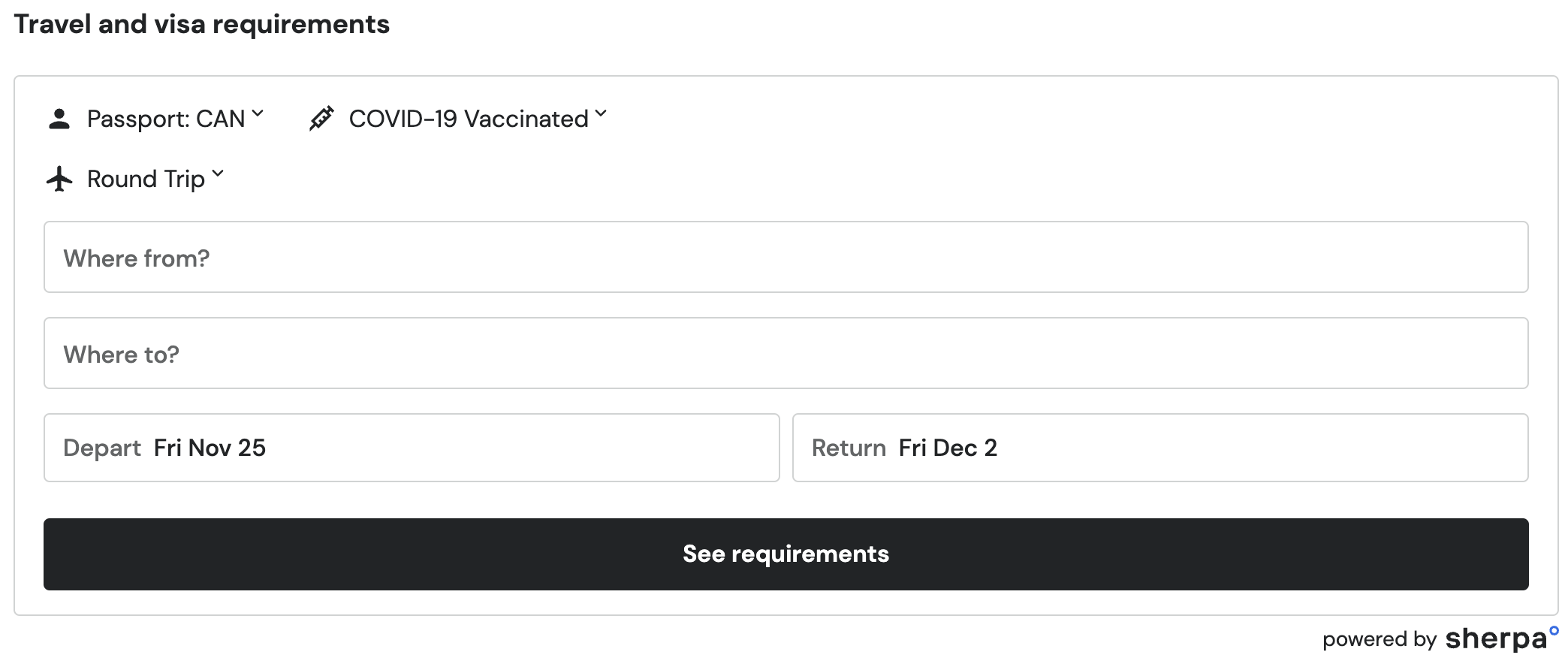Trip Element Quick Start
Get up and running in 5 minutes
Trip Element
Implementing the Trip Element with the SDK is quick and simple.
In the following guide, we will show you how to embed the Trip Element on a page in 3 simple steps.
We will also show you some additional customization options for more advanced users.
Video Link
Below you can find a video walkthrough of this Quick Start:
Step 1: Setup sherpa° SDK
You need to include the sherpa° SDK by adding the script tag to the head of your HTML file and include your unique APP_ID provided by sherpaº.
You will need to select the appropriate URL and APP_ID depending on whether you are using our Ssandbox or Production environment:
<!-- PRODUCTION Environment -->
<script src="https://sdk.joinsherpa.io/widget.js?appId={{APP_ID}}" defer></script>
<!-- SANDBOX Environment -->
<script src="https://sdk-sandbox.joinsherpa.io/widget.js?appId={{SANDBOX_APP_ID}}" defer>"</script>
Step 2: Place tag
Place an empty <div> tag on your page where you want the Trip Element to appear.
<div id="sherpa-trip-element"></div>
Step 3: Create element
Use the sherpaº SDK to create an instance of the Trip Element and mount it to the <div> tag you created in step 2.
const elementConfig = {
placement: "discovery"
}
function onSherpaEvent(event) {
// Ensure that the sdk is loaded before creating the element:
if (event.type === 'sdkLoaded') {
$sherpa.V2.createElement('trip', elementConfig).mount('#sherpa-trip-element');
}
}
You should see the Trip Element appear on your page.

Personalization
To provide the best user experience, you can pre-fill the Trip Element with a traveller's details.
In the example below, we will pre-configure the following parameters for an eVisa & Travel Requirements Trip Element:
- Element placement
- Traveller's nationality
- Origin
- Destination
- Departure and arrival date
- Flight number
Choose which properties to pre-configure
In the example below we are pre-configuring the above properties that are common in a Manage My Booking (MMB) page. These were chosen for demonstration purposes only. For your use case, you can choose to pre-configure all, some, or none of these properties
The data passed as a part of configuration will also be used to pre-fill the application of the traveller. This will reduce the probability of mistakes and the application time, and ultimately lead to a better user experience.
const elementConfig = {
// 1. Element Placement: Where the Element is being placed on your site e.g. mmb, discovery
placement: "mmb",
travellers: [
{
// 2. Define the traveller's Nationality:
nationality: "USA",
}
],
segments: [
// Outbound Segment
{
segmentType: 'OUTBOUND',
// 3. Define Origin Airport:
origin: {
airportCode: 'JFK',
},
destination: {
// 4. Define the Destination Airport:
airportCode: 'HAN',
},
// 5. Define the Departure & Arrival Date
departureDate: '2022-11-25',
arrivalDate: '2022-11-25',
// 6. Set the flight number
flightNumber: 'AB123'
},
// Return Segment
{
segmentType: 'RETURN',
origin: {
airportCode: 'HAN',
},
destination: {
airportCode: 'YYZ',
},
departureDate: '2022-12-02',
arrivalDate: '2022-12-02',
flightNumber: 'XY4321'
}
]
}
function onSherpaEvent(event) {
// Ensure that the sdk is loaded before creating the element:
if (event.type === 'sdkLoaded') {
$sherpa.V2.createElement('trip', elementConfig).mount('#sherpa-trip-element');
}
}
The output of the above example is shown below:

Updated over 1 year ago
